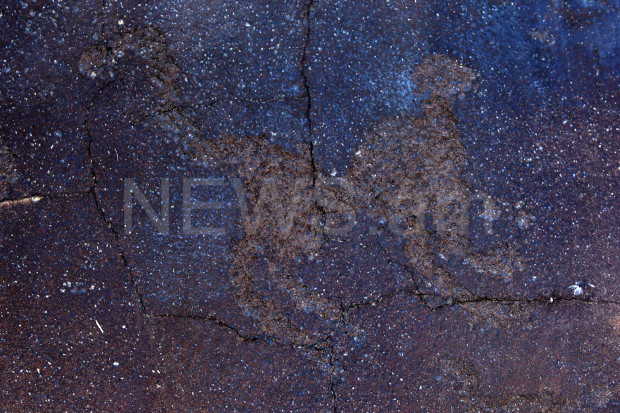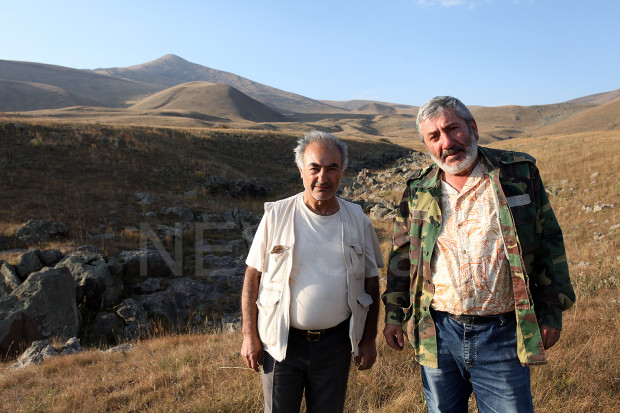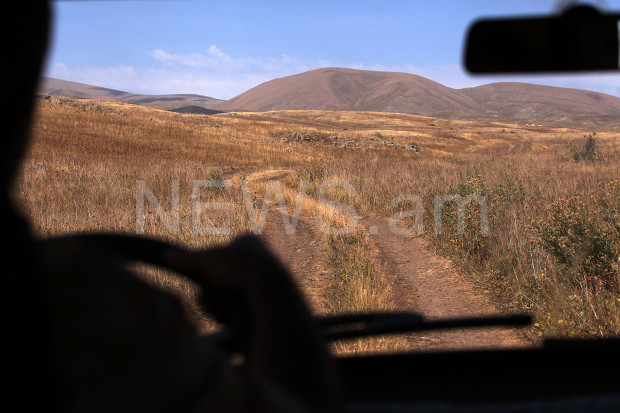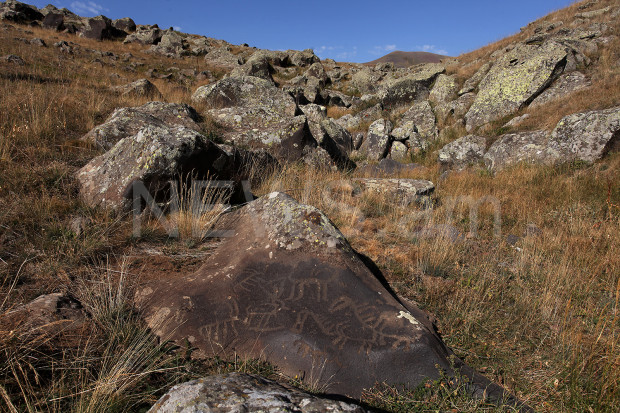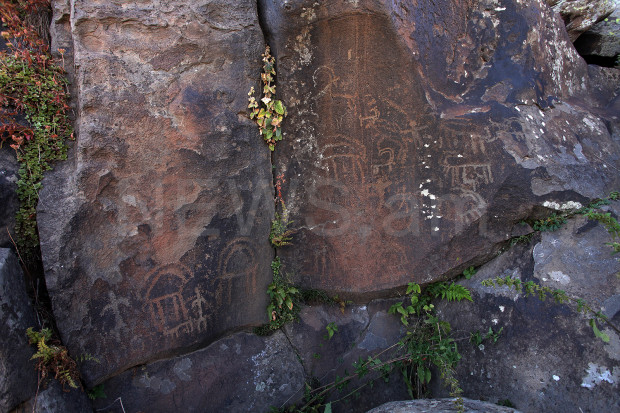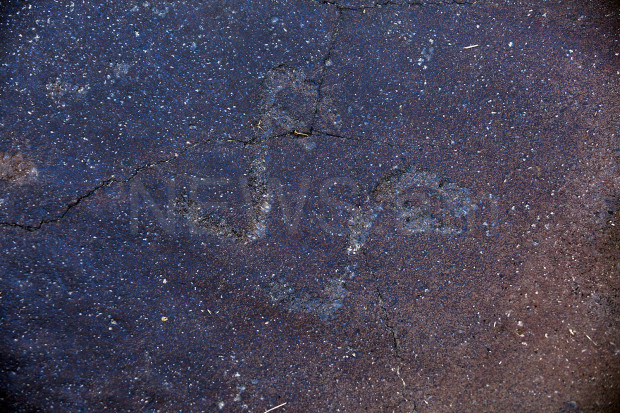
By Viorica Vladica
ArmeniaNow correspondent A group of four to five men equipped with small shovels and brushes are digging tirelessly a hole looking like a crater and each piece they find is a smile on their faces and an occasion for later debates. Their findings, more valuable than jewels, are slices of history.
Just days before Armenia's first snow halts their work, the men are digging on a mild and sunny autumn day, as they have for more than a year at the site, Agarak, a six stone multiplex believed to date since the Early Bronze Age.
The site, about 30 km from Yerevan, is mostly still a sheltered field with only five percent of its pre-historic and ancient assets brought to light. But the archaeologists promise an out of this world exposure of cultures and civilizations when they finish their work.
Even the President visited the place last year and certified it as a State protected monument. For archaeologists the President's decision was good news since it gave them the freedom to apply for grants and it allowed them to drive away the peasants who were destroying the 6,000 years old tombstones with their agricultural works.
Some of the flat fields between the multiplexes are still worked by the peasants who live in the nearby village of Voskehat. Although many legends about this place are haunting their community, the farmers did not know until the expedition started that there is a gigantic monument under their day-to-day life. Now they often ask archaeologists when they are going to see the promised monument.
"Well, not less than 150 years", says Boris Gasparyan, Director of Gfoeller Fund in Armenia. And he is not joking. Located on the western bank of the Amberd River, the site reaches an area of about 200 hectares and a team of 70 people and a budget of $140,000 a year is not an adequate amount for speedy excavation.
Their work, the archeologists say, is for coming generations and for history itself.
It is a flat surface pierced periodically by tuff cliff multiplexes, rocky hills and blocks of stone. Archaeologists say all these stones, entombed by time, bear traces of intensive work by both nature and man.
There are alcoves carved into the cliffs, as well as stair-like platforms leading to them, in addition to the stone structures. All these multiplexes, including a series of horseshoe-shaped configurations and channels linking them, plus trapezoidal sacrificial altars, make the landscape a multi-stratum monument.
The examination of layers shows that the site was subsequently inhabited in various archaeological periods. The first constructions originate from the Early Bronze Age and the latest ones date from the 17th century AD.
"For the time being," says Gasparyan, "excavations are being conducted only at the first cliff plateau of the northern complex of Agarak. The street discovered at the northeast edge of this site, as well as the presence along both sides of the street of houses with round floor plans and square external corners, indicate that there was a town here in the Early Bronze Age."
The street discovered in this site has been named Gfoeller Avenue, in honor of the brothers from the United States who created a special fund for archaeological digs in Armenia.
The location has many crypts, smaller and larger, that in Early Bronze time were shaped for pagan ritual purposes, like sacrifices or burials, but later on served as wine presses and wine storages.
During the excavations, archaeologists also found a great amount of ceramic fragments, terra cotta statues; round and horseshoe-shaped candle lamps, jewelry and coins.
It is said that Agarak had developed a flourishing economy and commerce, especially during the 3rd and 4th centuries BC, as well as during the 2nd and 4th centuries AD. The greatest evidence for this development is the discovery of painted urban pottery, a drachma of Alexander the Great, a silver coin of Octavian Augustus and several rings found in late antique burials.
When it comes to the discovery of Agarak, Pavel Avetisyan, one of the expedition's leaders, says it is "a gift from heaven".

"It is a cultural phenomenon that will help us to build an image of what was here thousands of years ago."
Among the treasures, a ceramic zoomorphic pot best shows the skills of potters during the 8th-6th centuries BC. It is worked with polish and has various ornaments. Archaeologists say the representation of a ram, with its head on the pot mouth and its genital organs at the bottom, symbolizes fertility and also the patriarchal system of the Urartu times.
But to bring the pot to how it looks today took tremendous work. It is not enough to find the ceramic pieces on the field and put them in a glass case in a museum.
First, archaeologists fix the spot where the objects are found. Then, very carefully, like surgeons during an operation, they are taking them out of the ground. Discovered fragments are then brought into the laboratory to be vigilantly cleaned.
Then a restoration crew goes to work, putting the pieces into a single object.
"I like everything connected with the restoration", says Lilit Manukyan, who is doing this job for eight years, "because at the beginning it is like a mystery, and in the end it is the unbinding of this work. It is like a puzzle."
Indeed, the site of Agarak, which contains hundreds of thousands similar objects makes Armenians proud of what is preserved in their country. But the more is discovered the more remains to be discovered.
Maybe 150 years is too much for a lifetime but insignificant for a clash of civilizations gathered all in the site of Agarak. As the archaeologists say: "Maybe in 150 years our descendants will walk on Gfoeller Avenue and say: 'This is an Early Bronze street'."
(To see a photo gallery of the work at Agarak, visit www.patkerphoto.com)
Inside
Uneasy Relations: Armenians in Russia await outcome of contentious trial
Full story
--------------------------------------------------------------------------------
Self-sustained Living: Building managers meet to discuss concepts of condominium life
Full story

Buried Secrets: Archeological site holds centuries of history
Full story
Write us at: info@armenianow.com
Copyright ArmeniaNow 2002. All rights reserved.
Articles may be reproduced, provided ArmeniaNow is cited as the source.





.jpg)
